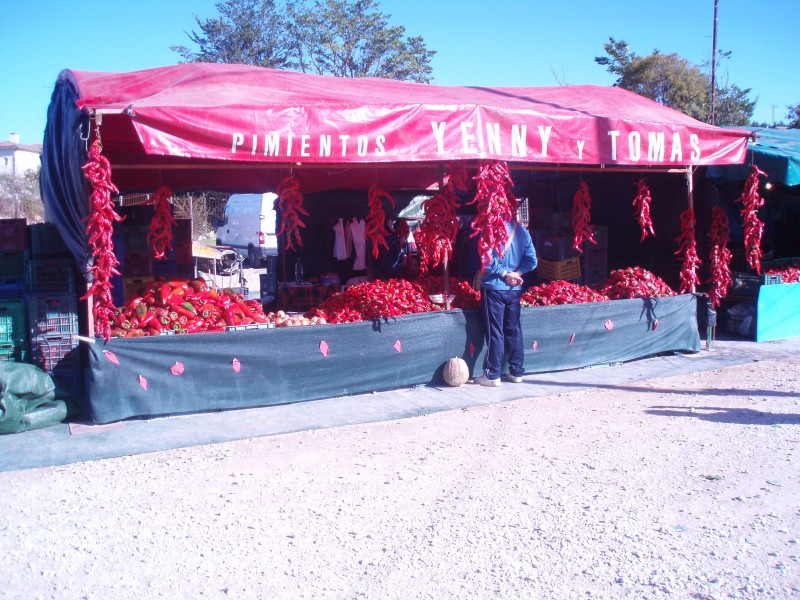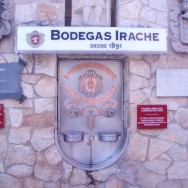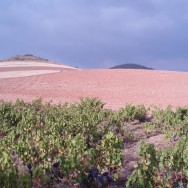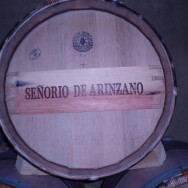These are some of the highlights of a whirlwind 2½ day press trip to Navarra. I was pleased to be going there, having been to the more famous Rioja a few times recently but never having had the opportunity to visit its somewhat Cinderella-like neighbour. We managed to cram in nine wineries in our short flying visit so below are only some of the highlights.
Fact or fiction?
Before going I had a few ideas about Navarra in mind – Atlantic influence, champion of rosado-style wines and much more innovative and export market driven than its more famous neighbour, Rioja. It also freely promoted the use of the international interlopers Cabernet Sauvignon and Chardonnay. Would these stereotypes be challenged or would they prove to be true?
Pilgrim’s way
Our first stop was Bodegas Irache, founded in 1891, near the town of Estrilla. Just beside the winery is a beautiful old church and monastery. This latter building is shortly due to be converted into a parador and has already been designated the second best in Spain. It is just a few paces away from the famous Camino de Santiago di Compostella, the historic pilgrimage route that goes across the top of Spain and finishes in the eponymously-named town. Bodegas Irache had the brilliant idea of establishing a font for pilgrims that dispenses drinking water through one tap and their wine from another. I thought this was such an excellent idea that I just had to try some of the wine myself. It was a light, lively and refreshing red, a bit like Beaujolais Nouveau at its best and probably just what weary pilgrims need to aid their flagging steps.
- Bodegas Irache
- Pilgrim’s font at Bodegas Irache
- Conchi Roig, Export Manager, Bodegas Irache
Rosé future?
Here and along the way at other wineries we discussed the role of rosé. I was surprised to hear that contrary to the trend in the UK, rosé sales were decreasing on the Spanish domestic market. We were told several times and by different people that consumers were drinking it less, considered it old fashioned, and were more interested in drinking red wines and even whites. Another argument put forward as to why Navarra made rosé a speciality was that it wanted to distinguish itself from Rioja rather than from any deeper love of this style of wine. Well that’s one myth dismissed then!
The beauty of older wines
After a brief tour of their museum and wine cellars, we moved on to the tasting room. The first two wines tasted were the Irache 2006 Chardonnay and Rosé Castillo Irache 2006. The owners were very proud of their ‘modern’ Chardonnay but for me it was a little simple, with pear-drop, estery aromas and a too heavily-oaked palate for the fruit to support it.
We moved on to the Crianza 2004 and Reserva 1999 matured in 100% American oak. I liked both of these wines. The Reserva had good weight and balance without being hefty, was soft and seductive marked by bright acidity and delicate warm strawberry fruit. Then came a really exciting wine – the Irache Gran Reserva 1996 – 24 months in oak, approximately 60% Tempranillo, 20% Garnacha, 20% Cabernet Sauvignon with a ‘touch’ of Graciano. This wine was still a youthful ruby in tone, with no overt signs of ageing; on the nose, some vanilla and pastry-shop aromas followed by faded roses and soft red fruits. But the palate stole the show – smooth and silky with excellent weight and texture, punctuated by a vibrant acidity and some firm, spicy tannins giving grip and backbone. It had great vitality and vibrancy for a wine more than 10 years old; indeed it seemed decidedly youthful.
As a grand finale, we were given the privilege of tasting the Real Irache Gran Reserva 1973. The colour, though tinged with garnet, was still youthful overall. On the nose there were lovely complex aromas of wood smoke, spice, cream, dark cherries and leather. It was silky-smooth and beautifully-textured with fine, gravelly tannins, vivid, refreshing acidity and a long, savoury finish. It was a beautifully integrated, supple wine yet still fresh and vibrant with plenty of life left. What a joy to taste!
The tasting was followed by a delicious lunch of local specialities such as jamón serrano, croquets, red peppers and cheese accompanied by the wines we had just tasted. We were also generously given two wines to take home, one of which the 1996 Reserva will definitely be on my Christmas drinking list.
Bodegas Nekeas
Bodegas Nekeas Valley, owned by a consortium of eight producers, was our next stop and it was just what we needed after the slight stupor engendered by a long, leisurely lunch. It was quite literally a breath of fresh air as we were taken up to a high point for a bird’s eye view of the valley below. The valley is only 4 km long yet there are big differences between the northern end at 650 metres high and the southern end at 430 metres; the southern end is one degree warmer for a start and there is a huge difference in rainfall of 150 mm in just the 4km distance. Bodegas Nekeas has vineyards scattered all across the valley so there are many differences in the various plots of each variety, making for good blending complexity. When we visited in mid-October, they were in the middle of harvest. They are usually one of the last to harvest in the whole of Spain due to the Atlantic influence felt here. That’s one belief confirmed then!
Windy valley
As the five of us stood and admired the contours of the valley below we could hardly hold our own against the cold wind called the Cierzo (a cold, dry, north-western wind that blows across this part of Navarra) and our eyes streamed as we swayed at an angle against the hillside like figures in a Lowry painting. The Cierzo is welcome here because of the humidity in the area and the wind helps to dry out the vines and prevent rot. They had yet to harvest the Cabernet and Garnacha but we were told that this vintage is going to be the best for a long time.
In this valley the day and night time temperatures differ hugely by between 10 and 20 degrees. Last week for example, we were told it was 25 degrees during the day and only 6 degrees at night. Here we were in the middle of Navarra physically but very much in a Northern Spanish climate. As if to reinforce this point they told us that they had had hail this year in the Southern part of the valley. We finally ended our King Lear-like encounter with the wind, coming down from our high vantage point to look at the vineyards themselves. At the southern end of the valley lies the San Juan Cabernet Sauvignon vineyard The landscape is more rolling and warmer (by 1 degree) and the vineyard has heavy, clay soils, giving some water stress and low vigour.
Interestingly, from next year they are going to irrigate here when necessary. Working closely with the local university, they will test vines for water stress in the belief that irrigation at critical times of high water stress gives earlier phenolic ripening and better balanced grapes. Going back to my current bug bear of overly alcoholic wines, this is one arguably natural way of keeping alcohol levels down and producing a more balanced wine by encouraging earlier phenolic ripeness. There is a strongly held belief that a stressed vine produces a better quality wine, but like many beliefs in the world of wine they do not always hold true; not all water stress is good and too much of it is detrimental to quality. In spite of all the controversy about irrigating vines within the EU, I think I would rather water the vines when they really need it than water the must when it is too late. In an arid country such as Spain, water is at a premium; Bodegas Nekeas have ambitious plans to get irrigation water by means of a huge canal project to bring water from the Pyrenees, 40km to the west and North of Navarra.
We then continued our ramble across to the Merlot vineyard with a different soil type and then to the old vine, bush trained Garnacha vineyard with a very red soil. Coonawarra eat your heart out – there is so much red soil in Spain!
- Carlos Biurrun, Export Manager, Bodegas Nekeas
- Nekeas Valley
- Vines, Nekeas Valley
Bodega Nekeas tasting
We then tasted through a range of their wines. All of the wines tasted were good, clean, fresh and well made but the ones that really stood out for me were those below:
Odiaza 2006 a characterful white wine with white flowers, acacia, and honey aromas. Warm pears and spice on the palate with a rich texture and good depth of flavour combined with a long, minerally finish.
Olazari 2002 ( 50% Garnacha, 50% Syrah blend). This was a very smooth, very well balanced wine with very lively acidity & intense cassis fruit, followed by a long finish. The tannins were firm but not rustic.
El Chaparral 2006 (Old Vine Garnacha – approx £9.00 to £10.00) violet and floral notes combine with sweet, dark cherries on both nose and palate. Again wonderfully smooth initial attack and texture punctuated with vibrant acidity. The elegant, perfume violet, note to fruit on the palate was at the core of this wine. This was a delicious combination of sweet fruit and vivid acidity, encased in silkiness. I gave it my highest mark here.
It was only day two and yet we had done so much but this day was a real challenge, with five winery visits in one day. The most I had attempted before was four! Edited highlights only follow below.
Bodegas Ochoa
The highlight of this day for me was our visit to Ochoa. This was a name I had known for a while and whose wines I had sold in my days at Wine Rack. I was very much looking forward to this visit and I was not disappointed. We were met by Adriana Ochoa. Ochoa are a family owned bodega and one of the smallest sized companies in the whole of Spain, but one of the largest owners of vineyards with 145 ha in Navarra. Adriana was one of those bright, open-minded young winemakers who had travelled and worked on vintages abroad before coming back to take on the winemaking side of the family business.
She did the 2004 vintage side by side with her father, then she made the 2005 whites, but the 2006 and 2007 wines are all her own. Previously, she had worked with Louisa Rose at Yalumba (whose Viognier in particular had impressed me at a tasting a few years ago) and she also worked for the Mouiex family in 2000 and did a study on ripeness there.
We had a brief tour of some of their vineyards while we chatted about methods. Grapes here are mostly picked by machine except for white grapes because the most important thing is to harvest at the right time. Their Moscatel however, is always harvested by hand. It takes 40 pickers 3 days to harvest 23 ha of Moscatel whereas it takes 3 weeks to pick the rest by machine. Like many others they were in the middle of harvesting when we visited. This year’s vintage had a particularly long ripening season and was a month later than usual. Normally, acidity in Tempranillo here is very low and pH is high but this year is very different and exceptional. The acidity on the Tempranillo is 5.5 TA while the potential alcohol is 13 %.
Biodyamics cropped up again – Adriana likes the idea and is experimenting with a small parcel of Tempranillo using these methods but she thinks it is probably impractical for 145 ha!
All of their investment goes into the vineyard.
They use oak barrels for four years and 80% of their barrels are made from split (not hand sawn) American oak coopered by Murua, a local cooper from Logroño.
New varieties
In the vineyards they have a little parcel of Viognier (Bodegas Nekeas also have some) but at the moment it is not allowed in the DO although they would like it to be. Adriana’s father, Javier Ochoa was a director of Oenology at Evena (Estación de Viticultura y Enología de Navarra) from 1981 until 1992 and although he chose Merlot and Cabernet Sauvignon to be accepted by the DO at the time, he always told Adriana that lots of other varieties would work well here too. Apart from all the usual varieties they have parcels of Syrah, Graciano and Moscatel. Graciano is very clone-dependent and they have both the good and the poor clones here. Apart from their other classic wines Ochoa are famous for their Moscatel. In fact they grafted Moscatel onto 10 year old Merlot rootstocks in the vineyard to have a ready source of more mature vines in this variety. They use ‘mass selection’ to select the best vines and have developed their own Moscatel clone.
Some of their vineyards near Traibuenas are near desert soils so they have to irrigate to survive. They lie in former riverbeds and are very stoney.
Ochoa wines tasted
We again tasted a whole range of Ochoa wines but the ones that impressed me the most were the Ochoa single vineyard rosé, Rosado de Lagrima 2005. It was a more serious style rosé with some depth of flavour which Adriana aptly described as ‘rosé with a red soul’. In spite of the trend away from rosé, they sell well on the home market.
The Ochoa Crianza 2004. Really lovely balance of cream, vanilla and strawberry fruit.
The Ochoa Vendimia Seleccionada 2000. fine, silky texture while still retaining purity of fruit.
I also thought the M de O Moscatel de Ochoa 2006 was a really fun, lively wine. Aimed at the younger market it was light, grapey and uncomplicated Moscatel at its best. The final wine Ochoa Moscatel 2006, made from Muscat á Petit Grains, was a delicious example of sweet Muscat. It combined honey, spice and musky notes with a sweetness and richness on the palate that was intercut with flavours of lemon zest.
Chivite (Señorío Arínzano Estate)
Our last stop (and probably the real highlight of the trip) was the most famous bodega in Navarra, Chivite, and their super-modern and expensive winery Señorío Arínzano. Designed by Rafael Moneo, a famous architect and friend of the family, this was lavish even by modern winery standards. The stainless steel tanks came complete with blades at the bottom to press the grapes and make press wine. There was a special low-ceilinged room for malolactic fermentation which we were not allowed to enter for fear of disturbing the temperature and even a bridge high up over the barrel-room to avoid vibrations from people passing through. It was clear that no amount of expense had been spared and it reminded me in places of a James Bond set.
But great wineries do not always mean great wine and I find it difficult to be impressed by vast amounts of money alone. However I am pleased to say the wines did not disappoint. They were very excited about our visit as the site was due to receive the first pago designation for Navarra within the next few days. To be given this status, the producer has to prove that there is a special terroir and all of the grapes must come from the estate. In addition all of the vineyards must be within the Navarra DO. Chivite’s Marife Blanco describes their philosophy as ‘terroir wines’.
- Chivite – Bridge over the barrel room
- Señorío Arínzano barrel
Chivite facts
- The Arínzano site covers 700 ha but only 350 ha are under vine.
- They started planting here in 1988 – before this it was it was farm land.
- The capacity is 1 million bottles but so far they only produce 200,000.
- Chivite hand-harvest all 350 ha but do have machine harvesters in case rain sets in.
- They choose to grow grapes organically as long as the quality of the grapes are not impaired and they recycle water.
- One excellent idea they have is to convert one of the small houses on the estate into a small 4-roomed hotel to encourage wine tourism.
New president – new beginnings
One theme that recurred throughout our trip both here and at other bodegas was that there was a real feeling of excitement and opportunity because of the newly appointed president of the Navarra Consejo Regulador, Pilar Garcia-Granero. Everyone we spoke to was enthusiastic about their new president as not only someone who was an experienced winemaker but someone who had a good understanding of the market. This was seen to be something that was sadly lacking in the previous president of the DO who many felt had outstayed his welcome, holding on to the position for 10 long years. In the past the DO was seen by many to have hindered and hampered the progress of Navarra, not least because little or no funds were allocated to export marketing. So Navarra has been languishing in the doldrums a little when it comes to innovation though not for the want of trying on the part of the best producers.
It’s now or never for Navarra
Finally Navarra’s producers have a chance to work together through the DO to achieve the quality changes they want with freedom from some of the legal constraints that have held them back. The new DO president has requested suggestions and opened the lines of communication with the producers. Among the things being discussed are which new grape varieties if any, should be allowed in the DO. Also to be discussed is the possibility of the DO re-tasting wines before release in order to give the final seal of approval and the DO designation; currently they are tasted after the vintage only. If it gets accepted this would be a strong stance to take and very much a move towards ensuring only the better quality wines are released onto the market, ultimately improving the image for all of the wines of Navarra.
So what has Navarra got going for it as a wine region? It has a stunningly beautiful landscape providing a variety of different terroirs and an Atlantic-influenced climate (a huge boon under the current threat of climate change) enabling it to produce elegant wines with freshness and vitality. It has some great grape varieties and some very passionate and committed winemakers. It now also has a new DO council who want things to change, so if any time was the right time for Navarra to take a giant step forward I’d say the time was now.
With huge thanks to David Lindsay at Lindsay May PR and the Navarra Consejo Regulador.
© 2007 – 2016, Susan Hulme MW. All rights reserved.









